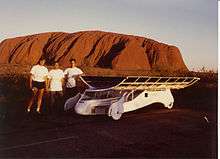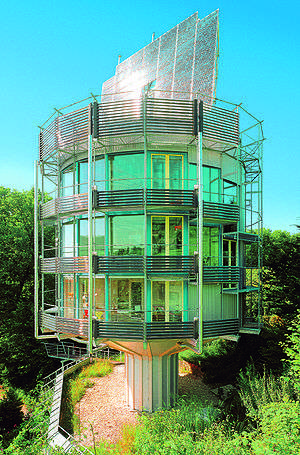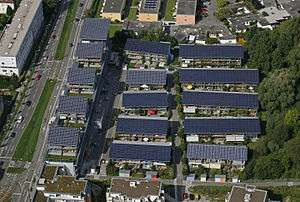Rolf Disch
| Rolf Disch | |
|---|---|
 | |
| Born |
1944 Freiburg im Breisgau, Baden-Württemberg Germany |
| Nationality | German |
| Alma mater |
Structural Engineering School Freiburg, University of Applied Sciences Konstanz, Guest Professor National School of Design Karlsruhe |
| Occupation | Architect |
| Awards |
1997 Eco-manager of the Year 2002 European Solar Prize 2003 Global Energy Award 2006 Germany's most beautiful housing community 2008 German Sustainability Award |
| Practice | Rolf Disch Solar Architecture |
| Buildings |
Heliotrope PlusEnergy Sun Ship |
| Projects | Solar Settlement |
Rolf Disch is a German architect, solar energy pioneer and environmental activist who has contributed greatly to the advancement and efficiency of solar architecture internationally. Born in Freiburg im Breisgau, Germany, Disch has dedicated particular focus to regional renewable and sustainable energy.
As head of his own architecture firm, Rolf Disch Solar Architecture, Disch has led Germany as the solar pioneer in respect to residential, retail and commercial building and design. In 1994, Rolf Disch built the Heliotrope in Freiburg which was the world’s first home to create more energy than it uses, as it physically rotates with the sun to maximize its solar intake. Disch then developed his concept, PlusEnergy, simply making it a permanent goal for his buildings to produce more energy than they consume in order to sell the surplus solar energy back into the grid for profit.
Rolf Disch’s biggest venture was completed in 2004 with the 59 PlusEnergy home Solar Settlement and the 60,000 sq ft (5,600 m2). PlusEnergy Sun Ship. In June 2009, Disch launched the 100% GmbH organization, with the aim to make Freiburg and its surrounding district the first 100% sustainable renewable energy region in the world.
Biography
Early years
Rolf Disch was born in the sunny south-western city of Freiburg im Breisgau, Baden-Württemberg, Germany in 1944. Disch first studied cabinetmaking in 1958 until later switching to masonry in 1961. It was not until 1962 however that Disch enrolled at the Structural Engineering School in Freiburg as a structural engineer. Disch knew he was passionate about building, although he found his true heart lied in architecture and after only one year, in 1963, he transferred as an architect to the University of Applied Sciences in Konstanz, Germany. After his graduation in 1967 Disch worked as an architect for two years and finally established his own firm in 1969, Rolf Disch Solar Architecture.
Activism
Rolf Disch’s environmentalism took its true form during the protest of building a nuclear power plant in Wyhl, Germany. As an educated environmentalist Disch saw this form of energy as destructive, while he knew that renewable energy and clean energy could be harnessed for healthy sustainable development. The protesters in Wyhl succeeded and the Wyhl nuclear power plant was never actualized. In fact, the Wyhl protest was the first successful resistance to nuclear expansion in Germany, later to be followed by several others. With this success in mind, Disch applied his architectural knowledge to the advancement of renewable and sustainable energy systems in building. The “Disch Design” was a concept he worked on from 1985 to 1988 building solar powered vessels of all sorts. During this period, in 1987, Disch raced a self-designed solar powered automobile in the World Solar Challenge, a race using only solar powered vehicles from Darwin, Australia to Adelaide, Australia.

Built with the Sun
With a focus on solar power use in his designs, Disch continued in 1993 with an initiative to make Sport-Club Freiburg the first solar soccer team in Germany with photovoltaic panels to power their stadium. Together with Coach Volker Finke, the Dreisam stadium in Freiburg was the first soccer stadium in Germany to install solar power, again to be followed by several club teams in the future. This pattern of pioneering swelled in 1995 when Disch revealed his groundbreaking Heliotrope design, a house that physically rotates with the sun to maximize sunlight and natural heat use. The Heliotrope was the first building worldwide to have a positive energy balance, meaning it generates more energy than it consumes. Different types of renewable and sustainable energy concepts in addition to solar power are used in the original Heliotrope, built in Freiburg’s renowned Vauban quarter. It was the first of three revolving wonders to be built in Germany. In line with his Heliotrope design, Disch’s PlusEnergy concept was born: create buildings that generate more energy than they use and sell the surplus of clean sustainable energy back into the power grid for profit. The key to the PlusEnergy concept was finding a solution not only for large expensive homes, like the Heliotrope, but rather also for the average sized and priced home. Thus in 2000 Disch contracted and began the development of a 50 PlusEnergy home housing community, the Solar Settlement. This PlusEnergy housing community was again revolutionary in that it was the first community in the world, in which every single home had a positive energy balance from which they received an annual profit from energy sales. With triumph the Solar Settlement drew many believers, tenants and funding which led to yet another successful PlusEnergy project. Directly next to the Solar Settlement Disch built the Sun Ship. The Sun Ship is the commercial accompaniment to the Solar Settlement and it includes 60,000 sq ft (5,600 m2). of commercial and retail space, while housing 9 PlusEnergy penthouses on its roof. Though the unique style of retail, commercial and residential integration is used throughout Europe, this exceptional structure meets the PlusEnergy standard with a positive energy balance due to its utilization of the most up-to-date building technology. The ingenuity of these projects has carried Rolf Disch and his architecture firm to the top of Germany’s solar totem poll and have demonstrated the perfect examples of modern sustainable development.
PlusEnergy
PlusEnergy is a coined concept developed by Rolf Disch that indicates a structure’s extreme energy efficiency so that it holds a positive energy balance, actually producing more energy than it uses. With the completion of his private residence, the Heliotrope, in 1994, Disch had created the first PlusEnergy house in the world. The sheer logic of a home that creates more energy than it consumes made perfect sense to Disch. His next goal in its development was thus the mass application of the concept to residential, commercial and retail space. As the concept further developed and gained financial backing as well, Disch built several more projects with PlusEnergy certifications. PlusEnergy is a simple concept that has been materialized in a technical design. “PlusEnergy is a fundamental environmental imperative,” Disch claims.[1] Disch believes that passive building isn’t enough because passive homes still emit CO2 into the atmosphere – we can solar activate our homes!
Heliotrope
Built originally in 1993 as the private residence and special project of Rolf Disch, the Heliotrope is a one-of-a-kind design. The Heliotrope in Freiburg was the first building in the world to create more energy than it uses, of which is entirely renewable, emissions free and CO2 neutral. The structure physically rotates to track the sun, which allows it to harness the maximum natural sunlight and warmth possible. Several different energy generation modules are used in the building including a 603 sq ft (56.0 m2) dual-axis solar photovoltaic tracking panel, a geothermal heat exchanger, a combined heat and power unit (CHP) and solar-thermal balcony railings to provide heat and warm water. These innovations in combination with the superior insulation of the residence allow the Heliotrope to produce anywhere between four and six times its energy usage depending on the time of year. The Heliotrope is also fitted with a grey-water cleansing system and built-in natural waste composting. At the same time Freiburg’s Heliotrope was built, Hansgrohe contracted Rolf Disch Solar Architecture to design and build another Heliotrope to be used as a visitor’s center and showroom in Offenburg, Germany. A third Heliotrope was then contracted and built in Hilpoltstein, Bavaria to be used as a technical dental laboratory. Disch’s unique design accommodates different utilization from private residences to laboratories, and nevertheless maintains the structure’s positive energy balance. In addition to the original Heliotrope design, Rolf Disch has drawn plans for larger versions of the project to be built as a rotating hotel, which gives every guest a beautiful view, as well as administrative buildings and even an exhibition pavilion for the EXPO 2010 in Shanghai.
 Heliotrope in Freiburg
Heliotrope in Freiburg- Bird's eye view of the Heliotrope in Freiburg
 Heliotrope-Hotel Schloss Waretenstein
Heliotrope-Hotel Schloss Waretenstein
Solar Settlement
With the success of the Heliotrope, Rolf Disch wanted to apply his PlusEnergy concept to mass residential production. His new design for the PlusEnergy house gave way to the development of the Solar Settlement, a 50 PlusEnergy home housing community. This residential complex won such awards as House of the Year (2002), Residential PV solar integration award (2002), Germany’s most beautiful housing community (2006). It is the first housing community in the world in which all the homes produce a positive energy balance and which is emissions-free and CO2 neutral. Built between 2000 and 2005 in the Vauban quarter of Freiburg the design of each home offers maximum energy efficiency and turns energy bills into energy income. The Solar Settlement has proved Disch’s vision of a “fundamental environmental imperative” as these homes have exhibited more than 8 years of full occupancy and each produced more than 4,000 Euros ($5,600) each year in solar energy profits. Disch believes the image his community exhibits is equally as important as the eco-savings it brings. Disch says 50 homes that eliminate energy bills and feed clean sustainable renewable energy into the city’s grid is the imperative we need. They contribute towards the goal of sustainable ecological and economic development and show the entire world that communities like this are economical, beautiful, comfortable and in fact preferable. The tenants at the Solar Settlement do not claim to have made any compromises in their living situations but rather that they have both environmentally and economically improved. Made from Black Forest timber, the wood interior and natural lighting provide for happily lit spaces and a natural flow from room to room.
Sun Ship
Disch also morphed his PlusEnergy design concept into a large integrated office/retail building. The Sun Ship, located directly next to the Solar Settlement in Freiburg, uses its 60,000 sq ft (5,600 m2). for retail, commercial and residential space. The Sun Ship is home to a supermarket, convenience store and bakery-café on the first floor, offices and work spaces on the 2-4 floors and 9 penthouses on its roof. As a whole this building produces more energy than it consumes per year and utilizes the most up-to-date building technology. Some aspects that make this building particularly unique are its vacuum insulated walls, ventilation with 95% heat recovery, triple paned windows and its energy façade. As the first positive energy office building worldwide, the Sun Ship exhibits not only extreme efficiency but also a warm environment to work in. The office spaces are flanked on both the East and West sides entirely with windows, which maximizes natural lighting and employee views while it minimizes the energy wasted by artificial light. In addition to the office and retail space, two conference rooms, one large and one small, provide space for lectures, meetings and a showroom.
Community Planning
Community planning goes hand in hand with sustainable development and thus Rolf Disch dedicates much of his design and planning to the symbiosis of his projects' surroundings. A solar community generates identification and an enormous public image. Disch says he attracts great tenants, innovative undertakings and creative work places through his design. Disch always aims to create a community with combined uses for an ecological urban planning concept like traffic management – with wide, attractive walkways, bike routes and connections to public transportation. At the Solar Settlement for example, tenants and owners incorporate bike- and carsharing and the neighborhood has an extensive car-free zone with many public transportation connections. Disch also has incorporated community solutions for energy. For example, a biomass cogeneration unit is extremely expedient, which meets the (reduced) additional heating demands for his PlusEnergy homes.
Cultural influence
Rolf Disch has continued his environmental activism alongside his profession since the beginning. Aside from his contributions in design and community building sustainability, Disch has founded, partaken, and supported several environmental and energy interest groups. Disch cofounded three major energy organizations: Energie im Bürgerhand (Energy in citizens’ hands), 100% GmbH and FESA – Förderverein Energie- und Solaragentur Regio Freiburg (Development association for energy and solar businesses in the Freiburg region). Although these three associations aim to bring forth solar energy market growth Freiburg, 100% GmbH, founded in July, 2009, specifically seeks to make the Freiburg region a 100% sustainable renewable energy operating region. Disch’s contribution through these associations may be even more effective than his design concepts, as Freiburg is now the leading solar city in the leading solar country in the world. Meanwhile, Disch remains an active member of several national associations such as Eurosolar, Deutsche Gesellschaft für Sonnenenergie (German society for solar energy), Deutsche Gesellschaft für Nachhaltiges Bauen e.V.(German sustainable building council). His active participation in the local and national advancement of sustainable resources has influenced the market greatly and Disch continues to influence not only building but technology development, environmental politics and market sustainability.
Awards
2008 German Sustainability Award
2007-08 Japanese PEN-Magazine Creativity Award
2006 Germany's most beautiful housing community
2005 Wuppertal Energy and Environment Prize
2003 Global Energy Award
2002 European Solar Prize
2001 Photovoltaic Architecture Prize Baden-Württemberg
1997 Eco-manager of the Year
Selected works
- Heliotrope, Vauban Quarter Freiburg, 1994
- Heliotrope, Offenburg, 1994
- Heliotrope, Hilpoltstein, 1995
- Solar Settlement, Vauban Quarter Freiburg, 2002
- Sun Ship, Vauban Quarter Freiburg, 2004


 A PlusEnergy home designed by Rolf Disch Solar Architecture, 2000
A PlusEnergy home designed by Rolf Disch Solar Architecture, 2000
